The vacuum tension rolls market is expected to grow from USD 367.8 million in 2025 to USD 599.0 million by 2035, reflecting steady demand for precision web handling equipment. Key market dynamics are shaped by the increasing complexity of materials used in flexible packaging, coated films, specialty papers, and battery separator production. As production lines become faster and more automated, consistent tension control and web stability have become essential to maintaining product quality and minimizing waste. Vacuum tension rolls enable uniform traction through controlled negative pressure, preventing wrinkling, stretching, slippage, and micro-defects during processing. This ensures reliable substrate transfer at high line speeds, supporting continuous manufacturing efficiency. Growing adoption in the packaging and printing industries is also linked to the need for defect-free surfaces for lamination, coating, and digital printing workflows.
Additional dynamics influencing market growth include advancements in roll surface engineering, airflow management, and energy-efficient vacuum systems. Manufacturers are designing rolls with adjustable vacuum zones, enhanced wear-resistant coverings, and customizable configurations to match different substrate thicknesses and production environments. Battery manufacturing is emerging as a strong growth segment, where precise tension control is critical for coating uniformity and separator film integrity. Equipment lifespan, maintenance access, and compatibility with retrofitted production lines are becoming key purchasing considerations, favoring suppliers that offer technical support and process integration expertise.
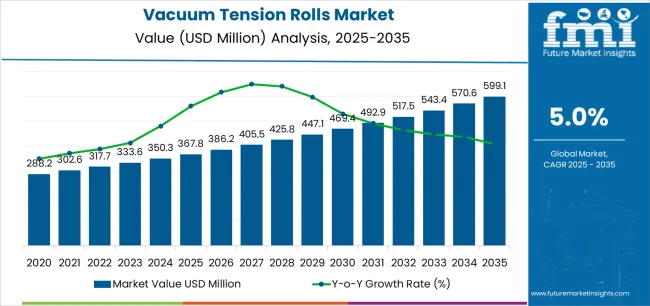
The latter half (2030-2035) will witness sustained growth from USD 469.4 million to USD 599.0 million, representing an addition of USD 129.6 million or 56% of the decade's expansion. This period will be defined by mass market penetration of specialized vacuum roll designs, integration with comprehensive production line platforms, and seamless compatibility with existing web handling infrastructure. The market trajectory signals fundamental shifts in how manufacturers approach web tension optimization and production quality management, with participants positioned to benefit from sustained demand across multiple device types and end-use application segments.
The Vacuum Tension Rolls market demonstrates distinct growth phases with varying market characteristics and competitive dynamics. Between 2025 and 2030, the market progresses through its technology adoption phase, expanding from USD 367.8 million to USD 469.4 million with steady annual increments averaging 5.0% growth. This period showcases the transition from basic tension control configurations to advanced adjustable device systems with enhanced web stabilization capabilities and integrated monitoring systems becoming mainstream features.
The 2025-2030 phase adds USD 101.6 million to market value, representing 44% of total decade expansion. Market maturation factors include standardization of web handling and production line protocols, declining component costs for specialized vacuum roll configurations, and increasing manufacturer awareness of tension control benefits reaching 95-98% web stability effectiveness in packaging and papermaking applications. Competitive landscape evolution during this period features established web handling equipment manufacturers like Maxcess and Hergen expanding their vacuum roll portfolios while specialty manufacturers focus on advanced device development and enhanced performance capabilities.
From 2030 to 2035, market dynamics shift toward advanced configuration integration and global manufacturing expansion, with growth continuing from USD 469.4 million to USD 599.0 million, adding USD 129.6 million or 56% of total expansion. This phase transition centers on specialized vacuum roll systems, integration with automated production networks, and deployment across diverse packaging and battery manufacturing scenarios, becoming standard rather than specialized applications. The competitive environment matures with focus shifting from basic tension control capability to comprehensive production optimization systems and integration with quality monitoring platforms.
| Metric | Value |
|---|---|
| Market Value (2025) | USD 367.8 million |
| Market Forecast (2035) | USD 599.0 million |
| Growth Rate | 5.0% CAGR |
| Leading Technology | Adjustable Device Type |
| Primary Application | Packaging Application Segment |
The market demonstrates strong fundamentals with adjustable device systems capturing a dominant share through advanced tension control and web stabilization optimization capabilities. Packaging applications drive primary demand, supported by increasing flexible packaging production and precise web handling technology requirements. Geographic expansion remains concentrated in developed markets with established manufacturing infrastructure, while emerging economies show accelerating adoption rates driven by packaging industry expansion and rising quality standards.
Market expansion rests on three fundamental shifts driving adoption across the packaging, papermaking, and battery sectors. First, web handling precision demand creates compelling operational advantages through vacuum tension rolls that provide immediate web stabilization and tension control without compromising production speeds, enabling manufacturers to meet stringent quality standards while maintaining operational efficiency and reducing defect rates. Second, production line modernization accelerates as manufacturers worldwide seek advanced vacuum roll systems that complement traditional web handling processes, enabling precise tension management and quality control that align with industry standards and production specifications.
Third, material handling enhancement drives adoption from flexible packaging producers and specialty material converters requiring effective tension solutions that maximize production quality while maintaining operational consistency during high-speed processing and web transfer operations. Growth faces headwinds from equipment cost challenges that vary across vacuum roll suppliers regarding the complexity of vacuum generation and precision engineering, which may limit adoption in cost-sensitive manufacturing environments. Technical limitations also persist regarding maintenance requirements and seal replacement cycles that may reduce effectiveness in continuous production scenarios, which affect operational uptime and maintenance scheduling requirements.
The vacuum tension rolls market represents a specialized yet critical web handling opportunity driven by expanding global flexible packaging production, manufacturing technology modernization, and the need for superior tension control in diverse processing applications. As manufacturers worldwide seek to achieve 95-98% web stability effectiveness, reduce material waste, and integrate advanced vacuum roll systems with automated platforms, vacuum tension products are evolving from basic web handling components to sophisticated production solutions ensuring material quality and operational leadership.
The market's growth trajectory from USD 367.8 million in 2025 to USD 599.0 million by 2035 at a 5.0% CAGR reflects fundamental shifts in web handling technology requirements and production optimization. Geographic expansion opportunities are particularly pronounced in Asia Pacific markets, while the dominance of adjustable device systems and packaging applications provides clear strategic focus areas.
Strengthening the dominant adjustable device segment through enhanced tension precision, superior web control, and automated adjustment systems. This pathway focuses on optimizing vacuum control, improving web stability, extending operational effectiveness to 95-98% tension consistency rates, and developing specialized configurations for diverse material applications. Market leadership consolidation through advanced mechanical engineering and automated control integration enables premium positioning while defending competitive advantages against fixed configurations. Expected revenue pool: USD 70-90 million
Rapid packaging production and manufacturing capacity growth across Asia Pacific creates substantial expansion opportunities through local manufacturing capabilities and supply chain partnerships. Growing flexible packaging industry and government manufacturing initiatives drive sustained demand for advanced vacuum roll systems. Localization strategies reduce import costs, enable faster technical support, and position companies advantageously for procurement programs while accessing growing domestic markets. Expected revenue pool: USD 55-75 million
Expansion within the dominant packaging segment (50.0% market share) through specialized vacuum roll designs addressing flexible packaging standards and high-speed production requirements. This pathway encompasses automated tension systems, quality control integration, and compatibility with diverse converting processes. Premium positioning reflects superior web handling performance and comprehensive production compliance supporting modern packaging operations. Expected revenue pool: USD 45-65 million
Strategic expansion into papermaking applications (30.0% market share) requires enhanced roll capacity and specialized vacuum configurations addressing paper production operational requirements. This pathway addresses web tension management, moisture control enhancement, and paper machine integration with advanced engineering for demanding production standards. Premium pricing reflects specialized material requirements and extended durability standards. Expected revenue pool: USD 40-55 million
Development of specialized vacuum roll configurations for battery applications (15.0% share) and other segments (5.0%), addressing specific electrode handling requirements and specialty material processing demands. This pathway encompasses cleanroom-compatible designs, precision tension alternatives, and application-optimized solutions for emerging manufacturing environments. Technology differentiation through specialized configurations enables diversified revenue streams while reducing dependency on single application platforms. Expected revenue pool: USD 30-45 million
Expansion of non-adjustable device segment (45.0% market share) through enhanced reliability, simplified maintenance, and cost-effective production requirements. This pathway encompasses standard tension applications, fixed-speed production lines, and conventional web handling installations requiring dependable stabilization characteristics. Market development through optimized mechanical engineering enables differentiated positioning while accessing price-sensitive markets requiring reliable tension solutions. Expected revenue pool: USD 25-40 million
Development of advanced vacuum roll configurations addressing automation requirements and Industry 4.0 integration across packaging and papermaking applications. This pathway encompasses sensor integration, predictive maintenance capabilities, and comprehensive performance monitoring. Premium positioning reflects technological leadership and automation expertise while enabling access to smart manufacturing procurement programs and digitally-integrated production partnerships. Expected revenue pool: USD 20-35 million
Primary Classification: The market segments by device type into Adjustable device and Non-adjustable device categories, representing the evolution from fixed tension systems to specialized configurations for comprehensive web handling optimization.
Secondary Classification: Application segmentation divides the market into Packaging, Papermaking, Batteries, and Other sectors, reflecting distinct requirements for tension precision, material compatibility, and production speed standards.
Regional Classification: Geographic distribution covers Asia Pacific, Europe, North America, and other regions, with developed markets leading adoption while emerging economies show accelerating growth patterns driven by manufacturing expansion programs.
The segmentation structure reveals technology progression from standard vacuum roll configurations toward specialized device systems with enhanced tension control and automation capabilities, while application diversity spans from flexible packaging production to specialized battery electrode and paper manufacturing requiring precise web handling solutions.

Market Position: Adjustable device systems command the leading position in the Vacuum Tension Rolls market with approximately 55.0% market share through advanced tension control properties, including dynamic adjustment capability, variable vacuum pressure, and operational optimization that enable manufacturers to achieve optimal web stability across diverse material types and production environments.
Value Drivers: The segment benefits from manufacturer preference for versatile tension systems that provide consistent web control, reduced material waste, and production flexibility without requiring equipment changeovers. Advanced device features enable automated tension adjustment, real-time monitoring, and integration with existing production lines, where tension precision and operational adaptability represent critical manufacturing requirements.
Competitive Advantages: Adjustable device systems differentiate through proven variable vacuum technology, responsive tension control, and integration with automated production protocols that enhance web handling effectiveness while maintaining optimal material quality suitable for diverse demanding applications.
Key market characteristics:
Non-adjustable device systems maintain cost-effective positioning in the Vacuum Tension Rolls market due to their simplified operation properties and reliable performance advantages. These systems appeal to manufacturers requiring standard tension capability with adequate performance for fixed-speed production applications. Market adoption is driven by conventional manufacturing expansion, emphasizing reliable web handling and operational efficiency through proven vacuum roll technology while maintaining competitive equipment costs.
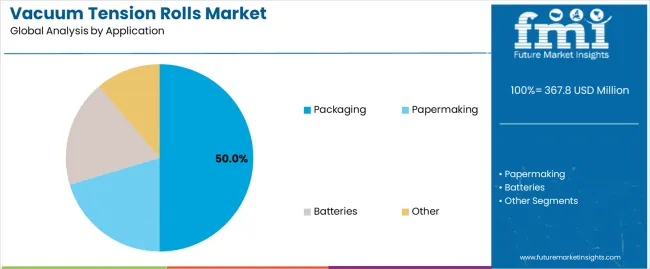
Market Context: Packaging applications dominate the Vacuum Tension Rolls market with approximately 50.0% market share due to widespread adoption of flexible packaging technology and increasing focus on web quality, tension control, and production efficiency applications that minimize material defects while maintaining manufacturing standards.
Appeal Factors: Packaging manufacturers prioritize tension reliability, web stability consistency, and integration with existing converting infrastructure that enables coordinated vacuum roll application across multiple production lines. The segment benefits from substantial flexible packaging investment and automation programs that emphasize the acquisition of vacuum roll systems for quality enhancement and waste reduction applications.
Growth Drivers: Flexible packaging expansion programs incorporate vacuum tension rolls as standard equipment for converting operations, while e-commerce growth increases demand for reliable web handling capabilities that comply with production standards and minimize material waste.
Market Challenges: Varying material characteristics and production speed differences may limit vacuum roll standardization across different packaging facilities or substrate specifications.
Application dynamics include:
Papermaking applications capture approximately 30.0% market share through specialized tension requirements in paper production facilities, tissue manufacturing operations, and specialty paper processing applications. These operations demand robust vacuum roll systems capable of handling moisture-laden webs while providing exceptional tension consistency and production reliability.
Battery applications account for approximately 15.0% market share, while other segments capture 5.0%, including electrode production operations, specialty coating processes, and technical material converting requiring vacuum roll capabilities for precision handling and production optimization.
Growth Accelerators: Flexible packaging expansion drives primary adoption as vacuum tension rolls provide superior web control capabilities that enable manufacturers to meet stringent quality standards without excessive material waste, supporting production operations and converting missions that require precise tension management applications. Manufacturing automation infrastructure demand accelerates market expansion as producers seek effective web handling systems that minimize defect rates while maintaining operational effectiveness during high-speed processing and material transfer scenarios. Production investment spending increases worldwide, creating sustained demand for tension control systems that complement traditional web handling processes and provide quality enhancement in manufacturing environments.
Growth Inhibitors: Equipment cost challenges vary across vacuum roll suppliers regarding the complexity of vacuum generation and precision engineering, which may limit operational flexibility and market penetration in regions with budget constraints or cost-sensitive manufacturing operations. Technical performance limitations persist regarding maintenance requirements and seal replacement cycles that may reduce effectiveness in continuous production or high-temperature conditions, affecting operational uptime and service scheduling requirements. Market fragmentation across multiple industry standards and material specifications creates compatibility concerns between different vacuum roll suppliers and existing production infrastructure.
Market Evolution Patterns: Adoption accelerates in flexible packaging and specialty paper sectors where production quality justifies vacuum roll investment costs, with geographic concentration in developed markets transitioning toward mainstream adoption in emerging economies driven by manufacturing expansion and quality awareness. Technology development focuses on enhanced vacuum systems, improved seal technology, and compatibility with automated production platforms that optimize web handling performance and production effectiveness. The market could face disruption if alternative tension control technologies or non-contact web stabilization innovations significantly limit the deployment of vacuum rolls in manufacturing applications, though vacuum tension technology's unique combination of reliable web contact, precise control, and proven performance continues to make it preferred in high-speed production.
The Vacuum Tension Rolls market demonstrates varied regional dynamics with Growth Leaders including China (6.8% CAGR) and India (6.3% CAGR) driving expansion through manufacturing capacity additions and packaging industry development programs. Steady Performers encompass Germany (5.8% CAGR), Brazil (5.3% CAGR), and United States (4.8% CAGR), benefiting from established converting industries and advanced web handling technology adoption. Mature Markets feature United Kingdom (4.3% CAGR) and Japan (3.8% CAGR), where specialized precision packaging applications and production integration support consistent growth patterns.

| Country | CAGR (2025-2035) |
|---|---|
| China | 6.8% |
| India | 6.3% |
| Germany | 5.8% |
| Brazil | 5.3% |
| United States | 4.8% |
| United Kingdom | 4.3% |
| Japan | 3.8% |
Regional synthesis reveals Asia Pacific markets leading adoption through manufacturing expansion and web handling technology infrastructure development, while European countries maintain steady expansion supported by converting technology advancement and quality standardization requirements. North American markets show moderate growth driven by flexible packaging applications and automated production integration trends.
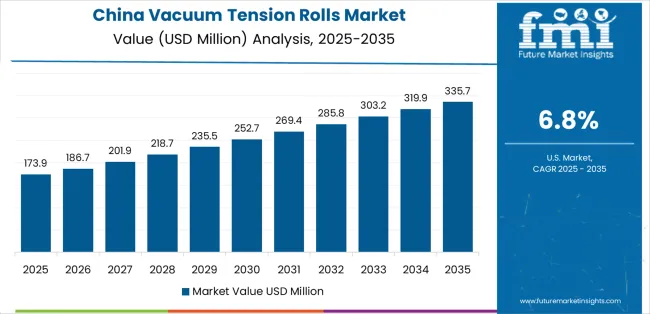
The Chinese market emphasizes advanced web handling features, including precision tension control and integration with comprehensive production management platforms that manage web stability, quality monitoring, and manufacturing optimization applications through unified automation systems. The country demonstrates strong growth at 6.8% CAGR, driven by packaging industry expansion, manufacturing modernization initiatives, and emerging flexible packaging development that support vacuum roll integration. Chinese manufacturers prioritize operational effectiveness with vacuum tension rolls delivering consistent web control through advanced device capabilities and production adaptation features.
Technology deployment channels include major packaging converters, specialized equipment suppliers, and manufacturing procurement programs that support professional applications for complex flexible packaging and specialty material applications. Production platform integration capabilities with established converting systems expand market appeal across diverse operational requirements seeking reliable tension control and quality benefits. The expanding packaging manufacturing base and accelerating e-commerce growth create sustained demand, while innovative applications in battery production and technical materials open new growth avenues.
Performance Metrics:
Advanced converting market in Germany demonstrates sophisticated vacuum roll deployment with documented operational effectiveness in packaging production applications and specialty manufacturing facilities through integration with existing production systems and web handling infrastructure. The country leverages engineering expertise in precision mechanics and automation systems integration to maintain strong growth at 5.8% CAGR. Industrial centers, including Baden-Wurttemberg, Bavaria, and North Rhine-Westphalia, showcase premium installations where vacuum roll systems integrate with comprehensive production platforms and quality management systems to optimize web handling performance and manufacturing effectiveness.
German manufacturers prioritize equipment reliability and EU compliance in vacuum roll selection, creating demand for advanced tension systems with features, including automated control and performance monitoring systems. The market benefits from established converting infrastructure and a willingness to invest in web handling technologies that provide long-term operational benefits and compliance with international manufacturing and quality standards.
Market Intelligence Brief:
The USA vacuum tension rolls market demonstrates sophisticated deployment across converting applications with documented effectiveness in flexible packaging production and specialty material manufacturing facilities through integration with comprehensive automation systems and production infrastructure. The country leverages advanced engineering capabilities in manufacturing automation and web handling technologies to maintain moderate growth at 4.8% CAGR. Industrial centers, including Wisconsin, Ohio, and North Carolina, showcase premium installations where vacuum roll systems integrate with comprehensive production platforms and automation networks to optimize web handling quality and manufacturing effectiveness.
American manufacturers prioritize production efficiency and quality compliance in vacuum roll development, creating demand for automated tension systems with features, including sensor integration and predictive maintenance capabilities. The market benefits from established flexible packaging infrastructure and willingness to invest in web handling technologies that provide long-term production benefits and compliance with FDA and manufacturing standards.
Market Intelligence Brief:
The UK vacuum tension rolls market demonstrates advanced quality deployment with documented operational effectiveness in packaging production applications and specialty converting facilities through integration with existing quality compliance systems and manufacturing infrastructure. The country leverages engineering expertise in web handling quality and production systems integration to maintain steady growth at 4.3% CAGR. Industrial centers, including West Midlands, Yorkshire, and Scotland, showcase installations where vacuum roll systems integrate with comprehensive quality platforms and production management systems to optimize regulatory compliance and web handling effectiveness.
British manufacturers prioritize equipment quality and regulatory compliance in vacuum roll development, creating demand for certified tension systems with features, including quality documentation and performance tracking. The market benefits from established converting infrastructure and commitment to invest in web handling technologies that provide long-term quality benefits and compliance with UK and EU manufacturing standards. Flexible packaging applications, specialty paper systems, and quality-focused production programs drive diversified demand across multiple application segments.
Strategic Market Indicators:
Vacuum tension rolls market in India demonstrates rapid expansion deployment with documented operational effectiveness in packaging production applications and manufacturing facilities through integration with emerging converting systems and production infrastructure. The country leverages growing engineering capabilities in manufacturing equipment and web handling systems integration to achieve high growth at 6.3% CAGR. Industrial centers, including Maharashtra, Gujarat, and Tamil Nadu, showcase expanding installations where vacuum roll systems integrate with comprehensive production platforms and distribution networks to optimize market penetration and web handling effectiveness.
Indian manufacturers prioritize equipment accessibility and performance standards in vacuum roll development, creating demand for cost-effective tension systems with features, including simplified operation methods and reliable web control. The market benefits from expanding flexible packaging infrastructure and willingness to invest in international-standard web handling technologies that provide production quality and compliance with global manufacturing standards.
Market Intelligence Brief:
Japan's vacuum tension rolls market demonstrates precision deployment with documented operational effectiveness in specialty packaging applications and precision converting facilities through integration with advanced production systems and quality control infrastructure. The country leverages engineering excellence in mechanical precision and manufacturing systems integration to maintain steady growth at 3.8% CAGR. Industrial centers, including Tokyo, Osaka, and Nagoya, showcase installations where vacuum roll systems integrate with comprehensive quality platforms and production systems to optimize manufacturing excellence and web handling effectiveness.
Japanese manufacturers prioritize equipment precision and quality excellence in vacuum roll development, creating demand for ultra-premium tension systems with features, including micro-precision control and quality integration systems. The market benefits from established precision converting infrastructure and commitment to invest in highest-quality web handling technologies that provide superior production positioning and compliance with stringent Japanese manufacturing standards.
Strategic Market Indicators:
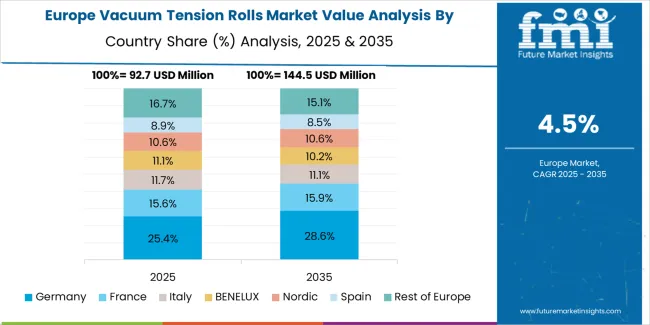
The Vacuum Tension Rolls market in Europe is projected to grow substantially over the forecast period, with Germany expected to maintain its leadership position with a significant market share supported by its advanced converting infrastructure and major packaging manufacturing centers in Baden-Wurttemberg and Bavaria. France follows with strong market presence, driven by comprehensive flexible packaging programs and specialty converting initiatives. The United Kingdom holds substantial market share through specialized packaging production activities, quality manufacturing applications, and precision converting operations. Italy commands notable market presence through strong packaging converting and specialty paper projects.
Spain accounts for growing market share aided by manufacturing expansion and converting equipment adoption. Netherlands maintains steady share driven by specialty packaging applications and web handling demand. The Rest of Europe region is anticipated to show steady adoption, reflecting consistent growth in Nordic countries, flexible packaging expansion in Central European markets, and manufacturing upgrades across Eastern European converting facilities.

In Japan, the Vacuum Tension Rolls market prioritizes adjustable device systems, which capture the dominant share of flexible packaging and specialty material installations due to their advanced features, including precision tension control optimization and seamless integration with existing automated production infrastructure.
Japanese manufacturers emphasize quality, adaptability, and long-term operational excellence, creating demand for adjustable device systems that provide exceptional web stability capabilities and superior tension performance based on production requirements and quality standards. Non-adjustable devices maintain secondary positions primarily in standard converting applications and fixed-speed production installations where adequate tension control meets operational requirements without compromising manufacturing efficiency.
Market Characteristics:
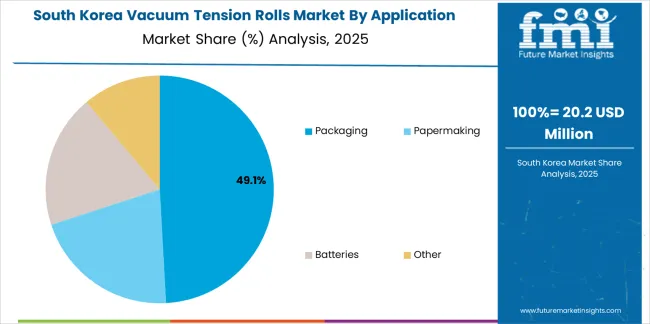
In South Korea, the market structure favors international web handling equipment manufacturers, including Maxcess, Hergen, and regional specialists, which maintain dominant positions through comprehensive product portfolios and established manufacturing networks supporting both packaging converting and specialty material installations.
These providers offer integrated solutions combining advanced vacuum roll systems with professional installation services and ongoing technical support that appeal to Korean manufacturers seeking reliable tension control systems. Local equipment distributors and mechanical contractors capture moderate market share by providing localized installation capabilities and competitive pricing for standard converting applications, while domestic manufacturers focus on specialized configurations and cost-effective solutions tailored to Korean manufacturing market characteristics.
Channel Insights:
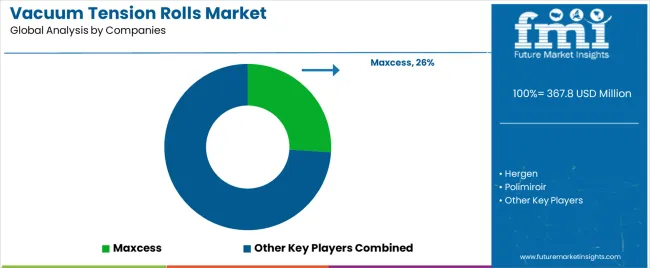
The Vacuum Tension Rolls market operates with moderate concentration, featuring approximately 10-12 meaningful participants, where leading companies control roughly 50-55% of the global market share through established manufacturing relationships and comprehensive web handling equipment portfolios. Competition emphasizes advanced device configurations, tension control reliability, and production integration rather than price-based rivalry. The leading company, Maxcess, commands approximately 26.0% market share through its extensive vacuum roll product line and global converting presence.
Market Leaders encompass Maxcess, Hergen, and Polimiroir, which maintain competitive advantages through extensive web handling expertise, global manufacturing networks, and comprehensive system integration capabilities that create customer loyalty and support premium pricing. These companies leverage decades of precision engineering experience and ongoing innovation investments to develop advanced vacuum roll systems with precision tension control and reliability features. Technology Innovators include NOBAG Nobs Engineering and regional specialists, which compete through specialized device focus and innovative vacuum capabilities that appeal to manufacturers seeking advanced web handling solutions and production optimization.
These companies differentiate through rapid product development cycles and specialized flexible packaging application focus. Regional Specialists feature equipment manufacturers focusing on specific geographic markets and specialized applications, including cleanroom-compatible systems and integrated automation solutions. Market dynamics favor participants that combine reliable vacuum technology with advanced control capabilities, including precision tension monitoring and automatic adjustment optimization features. Competitive pressure intensifies as traditional web handling equipment suppliers expand into specialty vacuum roll systems, while specialized converting equipment companies challenge established players through innovative device solutions and smart monitoring platforms targeting packaging and specialty material converting segments.
| Item | Value |
|---|---|
| Quantitative Units | USD 367.8 million |
| Device Type | Adjustable device, Non-adjustable device |
| Application | Packaging, Papermaking, Batteries, Other |
| Regions Covered | Asia Pacific, Europe, North America, Latin America, Middle East & Africa |
| Countries Covered | China, India, Germany, Brazil, United States, United Kingdom, Japan, and 20+ additional countries |
| Key Companies Profiled | Maxcess, Hergen, Polimiroir, NOBAG Nobs Engineering, TANKEN SEAL SEIKO, RV Industries, New Era, Wuxi Hongcheng Paper Machinery, GREASUN, Yuze Electromechanical Equipment |
| Additional Attributes | Dollar sales by device type and application categories, regional adoption trends across Asia Pacific, Europe, and North America, competitive landscape with web handling equipment manufacturers and converting suppliers, manufacturer preferences for tension precision and automation capabilities, integration with production line platforms and quality monitoring systems, innovations in vacuum technology and control excellence, and development of smart automation solutions with enhanced performance and manufacturing optimization capabilities. |
The global vacuum tension rolls market is estimated to be valued at USD 367.8 million in 2025.
The market size for the vacuum tension rolls market is projected to reach USD 599.1 million by 2035.
The vacuum tension rolls market is expected to grow at a 5.0% CAGR between 2025 and 2035.
The key product types in vacuum tension rolls market are adjustable device and non-adjustable device.
In terms of application, packaging segment to command 50.0% share in the vacuum tension rolls market in 2025.






Full Research Suite comprises of:
Market outlook & trends analysis
Interviews & case studies
Strategic recommendations
Vendor profiles & capabilities analysis
5-year forecasts
8 regions and 60+ country-level data splits
Market segment data splits
12 months of continuous data updates
DELIVERED AS:
PDF EXCEL ONLINE
Vacuum Self-priming Mobile Pumping Station Market Size and Share Forecast Outlook 2025 to 2035
Vacuum Skin Packaging Market Size and Share Forecast Outlook 2025 to 2035
Vacuum-Refill Units Market Analysis - Size and Share Forecast Outlook 2025 to 2035
Vacuum Leak Detectors Market Size and Share Forecast Outlook 2025 to 2035
Vacuum Insulation Panels Market Size and Share Forecast Outlook 2025 to 2035
Vacuum Pressure Encapsulated Transformer Market Size and Share Forecast Outlook 2025 to 2035
Vacuum Insulated Medium Voltage Switchgear Market Size and Share Forecast Outlook 2025 to 2035
Vacuum Rated Motors Market Size and Share Forecast Outlook 2025 to 2035
Vacuum Concentrators Market Size and Share Forecast Outlook 2025 to 2035
Vacuum Insulated Low Voltage Commercial Switchgear Market Size and Share Forecast Outlook 2025 to 2035
Vacuum Pressure Impregnated (VPI) Transformer Market Size and Share Forecast Outlook 2025 to 2035
Vacuum Insulated Pipe Market Size and Share Forecast Outlook 2025 to 2035
Vacuum Therapy Devices Market Size and Share Forecast Outlook 2025 to 2035
Vacuum Pressure Swing Adsorption Market Size and Share Forecast Outlook 2025 to 2035
Vacuum Grease Market Size and Share Forecast Outlook 2025 to 2035
Vacuum Truck Market Size and Share Forecast Outlook 2025 to 2035
Vacuum Thermoformed Packaging Market Size and Share Forecast Outlook 2025 to 2035
Vacuum Insulated Switchgear Market Size and Share Forecast Outlook 2025 to 2035
Vacuum Sealing Machine Market Size and Share Forecast Outlook 2025 to 2035
Vacuum Chamber Pouches Market Size and Share Forecast Outlook 2025 to 2035

Thank you!
You will receive an email from our Business Development Manager. Please be sure to check your SPAM/JUNK folder too.
Chat With
MaRIA